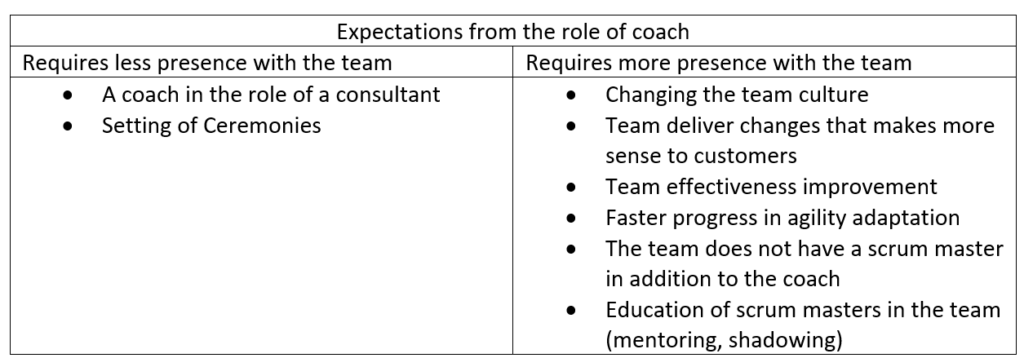In a number of companies, people have recently started to fill themselves in the role of agile coaches on a large scale. For example, in connection with the Spotify “framework”, we often encounter questions about how the role of an agile coach differs from a scrum master. Is the difference between these roles really just in the title? Or do they differ in the content of the work? Or are teams expected to do without a scrum master and coaches to manage multiple teams at once? I’d like to look at the number of teams today. And not to disappoint you, do not expect exact numbers here, because the correct settings vary depending on a number of parameters. Instead, you can find some tips to help you get to the right settings.
It is quite common that when you start with agile in a company, many people do not really know what to expect from the role of an agile coach or scrum master. Some companies then logically decide not to invest as much in these roles as the position deserves and prefer to wait until time will tell. If the coaches manage to show their value after some time, the company may decide to recruit from the outside or educate other coaches of their own.
However, the lack of coaches can complicate the ongoing agile transformation. Coaches are the agents of change in agile transformations. There may not be enough coaches in such a situation to cover all the teams that need it in the company. Therefore, first set the expectations from the coaches, what they should deliver to you in the company and only on the basis of this solve the expectations of how many teams the coaches can manage in parallel.
Lack of trust or loss of context
What can a badly set number of teams per coach actually lead to? If you overdo it and set expectations for coaches for too many teams at once, sooner or later these problems are likely to appear:
- Lack of trust of the coach in the team: if the coach does not manage to devote enough time to the team to show his value, he will not gain the trust of the team. Overloading will lead to a fragmentation of the focus of coaches and the limitation of their contribution to a “mere facilitator of ceremonies”.
- Loss of context: if you already have a senior coach, it can help multiple teams at once at first, as the teams’ initial mistakes are repeated. It works in “look and see” mode. But, unfortunately, this is not a permanent solution to the situation. If there are many teams and teams are gradually developing, they will gradually lose the ability to respond appropriately to the needs of the team without maintaining context. And again, maintaining context requires being with the team for a while. If the problem is not solved, the value of the coach may be limited to passing on theoretical advice to the team without context, or constantly asking how the team works (in the best case).
It is also true that if you are not in a flexible startup, do not count on the fact that an agile coach can coach many teams at once and the team will then move on its own without a scrum master and only with an occasional visit from a coach – consultant . To begin with, set expectations from the coach and this will help you determine the demands on his presence with the team.
Expectations from the role of a coach
So if you want to get to how many coaches you actually need, try to think about the expectations from the coach. Are these benefits that require being more with the team, or is an occasional visit enough? Some expectations are listed in the following table.

What else affects the determination of the number of teams per coach
Expectations from a coaching role aren’t the only factor you should take into account. Before you decide on setting the number of teams per coach, try to think about the following points:
- How long your people have worked in the traditional way of development: the more they are used to the original style of work, the more effort and time it will take to change it.
- Company size and team flexibility – for larger companies, we usually find a large specialization of roles and also more process-oriented people. The transition to agility is a big change for these people and this usually brings with it a greater demand on the coach.
- Willingness to take responsibility: not all employees (but also external staff) in the company welcome greater responsibility for what the team delivers to its customers. The less willing people are to take responsibility in teams, the more challenging this change is for them and for the coach.
- Seniority of coaches: if an agile coach starts, he should not have more than 1 or 2 teams as well as a scrum master. The risk of losing confidence and possibly discouraging the team from being willing to give the opportunity to change in its functioning is quite high.
- If you have more senior coaches in your company, always consult the number of teams with them rather than with consulting companies. Consulting companies may not always have the right context for how your company operates and what your teams need.
What to do if you don’t have enough coaches
So what to do if we don’t have enough coaches and you can’t afford to hire more now? Here are some experiences that might help, at least temporarily:
- Start teams gradually: when you no longer have a choice with a number of available coaches, start at least the teams gradually, so that the load is distributed over time. In the meantime, some teams may be able to stabilize a bit and make room to help other teams.
- Educate your employee coaches: if you have senior coaches in your company, be sure to try to help you nurture other coaches internally. If you do not have seniors or they are busy, ask for help with development of one of the companies that are dedicated to agile on the market. Do not wait with the education of coaches, it will take its time.
- It’s better not to combine crafts with a coach: if you’re not a startup, combining other work fields with a coaching role is usually not a good idea. Often this leads to a fragmentation of the coach’s attention, and one or the other suffers.
- Prioritize where the coaches will be and where they won’t: if you can admit that there are not enough coaches, then you can decide where the coaches will be now and where they won’t yet. It’s often a better solution than when you’re trying to get coaches everywhere and then they can’t do anything properly. If you are still fine-tuning expectations from the benefits of coaches in the company, give the opportunity to teams that want agility and actively help with its development. This way, you can assess the contribution of coaches earlier and at the same time create sample teams with agile settings. Sample teams can then serve as inspiration for others.
- Coach rotation: coaches can also help each other across teams. For example, anyone who has good experience with an agile technique can help with its implementation in other teams. Here again, however, beware of fragmenting the focus. If a coach has too many teams, he will never earn their trust and there won’t be too many changes. A more senior coach can already prioritize their tasks, but this may not be true for people who are just starting out with this role and are just learning it.
And how is it with you? I will be glad if you write to us in the comments or in the mail what experience you have in determining the number of teams for your coaches or scrum masters.


Pingback: Will I save money if I release Scrum Masters? – Lucid Bay Digital
Pingback: 10 tips to earn trust with your team as a scrum master - Lucid Bay Digital